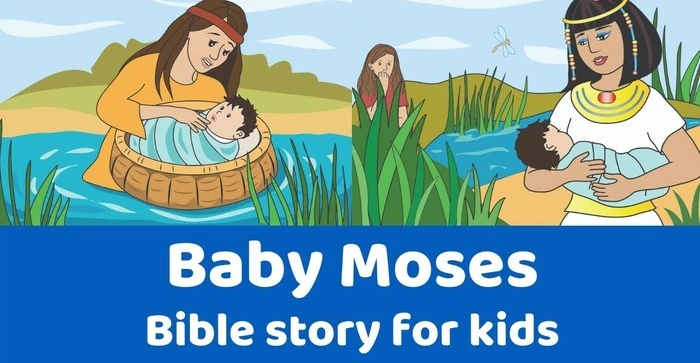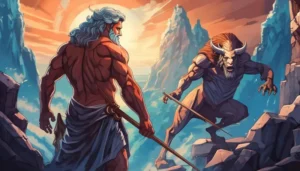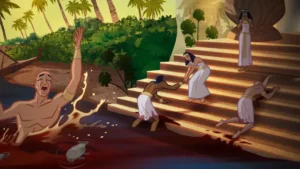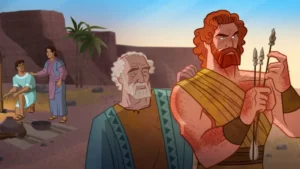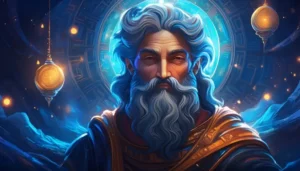The Story of Moses
Once upon a time, in a land far away, there lived a people who were enslaved and oppressed by the ruling Pharaoh of Egypt. Among them was a woman who gave birth to a baby boy, whom she named Moses. Knowing that the Pharaoh had ordered the death of all Hebrew baby boys, she placed Moses in a basket and set him adrift on the Nile River, hoping that someone would find and care for him.
As fate would have it, the basket was discovered by the Pharaoh’s daughter herself, who was out bathing in the river. She was moved by the sight of the helpless baby and decided to adopt him as her own. Little did she know, this act of kindness would set in motion a series of events that would change the course of history.
Moses grew up in the palace, living a life of privilege and luxury. However, he was always aware of his Hebrew heritage and was troubled by the oppression and slavery suffered by his people. One day, he saw an Egyptian taskmaster beating a Hebrew slave and he killed the taskmaster in a fit of rage. Realizing that he was in danger, Moses fled Egypt and settled in the land of Midian.
In Midian, Moses met and married a woman named Zipporah and became a shepherd. One day, while tending his flock, he saw a burning bush that was not consumed by the flames. From the bush, he heard the voice of God calling him to return to Egypt and lead his people out of bondage.
Moses returned to Egypt and, with the help of his brother Aaron, demanded that the Pharaoh release the Hebrew slaves. When the Pharaoh refused, God sent ten plagues upon Egypt, culminating in the death of the firstborn of every household. The Pharaoh finally relented and allowed the Hebrews to leave.
Moses led the Hebrews through the desert, but they soon found themselves trapped between the Red Sea and the pursuing Egyptian army. In a miraculous event, God parted the waters of the Red Sea, allowing the Hebrews to cross safely to the other side. When the Egyptians attempted to follow, the waters closed over them and they were drowned.
After their escape from Egypt, Moses led the Hebrews to Mount Sinai, where he received the Ten Commandments from God. He continued to lead his people through the wilderness for forty years until they finally reached the Promised Land.
The story of Moses is a testament to the power of faith and the resilience of the human spirit. It is a story of a man who overcame incredible odds to become a great leader and deliverer of his people.
The Story of Moses - Summary
The story of Moses is a tale from the Old Testament of the Bible. Moses was a Hebrew baby born into a world where his people were enslaved and oppressed by the ruling Pharaoh of Egypt. In an act of desperation, his mother placed him in a basket and set him adrift on the Nile River, hoping that someone would find and care for him. The basket was discovered by the Pharaoh’s daughter who adopted Moses as her own.
Moses grew up in the palace but was troubled by the oppression and slavery suffered by his people. After killing an Egyptian taskmaster, he fled to Midian where he married and became a shepherd. He heard the voice of God calling him to lead his people out of bondage and returned to Egypt with his brother Aaron to demand the release of the Hebrew slaves. After the Pharaoh refused, God sent ten plagues upon Egypt, culminating in the death of the firstborn of every household. The Pharaoh finally relented and allowed the Hebrews to leave. Moses led the Hebrews through the desert until they reached the Promised Land.
What were the Ten Plagues in the Moses Story?
In the Moses story, God sent ten plagues upon Egypt to persuade the Pharaoh to release the Hebrew slaves. The ten plagues were:
Water turned to blood: The Nile River and all water sources in Egypt turned to blood, making it undrinkable.
Frogs: Large numbers of frogs appeared throughout Egypt, causing a great nuisance.
Gnats or lice: Swarms of gnats or lice plagued the people and animals of Egypt.
Flies: Hordes of flies infested Egypt, making life miserable.
Pestilence: Cattle and other livestock throughout Egypt became sick and died.
Boils: Painful boils appeared on the skin of humans and animals in Egypt.
Hail: A violent hailstorm rained down upon Egypt, destroying crops and killing animals.
Locusts: Massive swarms of locusts devoured all the remaining crops in Egypt.
Darkness: A darkness so deep and thick descended upon Egypt that it could be felt.
Death of the firstborn: Every firstborn son in Egypt, including the Pharaoh’s own son, died in a single night.
The ten plagues demonstrated God’s power and convinced the Pharaoh to release the Hebrew slaves.
